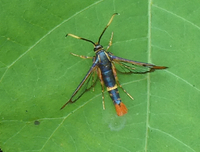Identification
Adult Markings: The following description of the male is based on those by Engelhardt (1946) and Eichlin and Duckworth (1988). The antenna is black with the apical one-half to one-third powdered with white or yellowish-white except for the black tip. The labial palp is yellow with some brownish-black apically. The head is black and the face glossy white, while the collar is pale yellow and slightly mixed with black above. The thorax is black, with the patagia along the sides narrowly touched with pale yellow inwardly. The abdomen is black and unbanded, and the anal tuft black above and sometimes mixed with orange or orangish-red scales basally. The anal tuft is long, narrow, and black with a pencil-like extension from the middle. The forewing is transparent, with the costa, veins, and large oblong discal mark black. The outer margin is broadly shaded with black, with black on the veins, and orange between the veins. The hindwing is transparent and narrowly margined with black. The legs are predominantly pale yellow and shaded with black scales. The tibia of the hindleg is very rough and golden yellow, while the tarsi are smooth, yellow, and shaded with black.
Wingspan: male = 18 mm; female = 20 mm. Forewing Length: 7-9 mm (Eichlin and Duckworth, 1988).
Adult Structural Features: Eichlin and Duckworth (1988) have a description of the male genitalia.
Adult ID Requirements: Identifiable from good quality photos of unworn specimens.
Immatures and Development: The larval life history and host plants are undocumented.

 »
»

 »
»